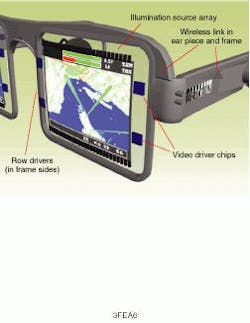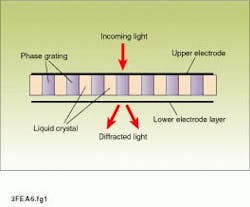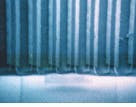Switchable optical elements merge optics and electronics
BILL PARKER
Switchable optical elements (SOEs) are a new class of optical device that combines diffractive structures with an electro-optic material. Like diffractive optical elements (DOEs) and holographic optical elements (HOEs) before them, SOEs are an emerging category of optical devices with broad usefulness. By incorporating SOEs, numerous products can be made with optical properties that are turned on and off by electrical signals, modulated at high frequencies, and manufactured at low cost (see "On the brink").
Switchable optical elements are made using microscopic diffractive structures fabricated on a transparent or reflective substrate that is subsequently covered with an electro-optic material. In a typical SOE, the substrate is first covered with a transparent conductive layer, then a phase grating with the required depth and pitch is fabricated on top of it. A cover is applied that also has a transparent conductive coating, and a liquid-crystal composition is introduced that fills the grooves of the grating (see Fig. 1).
The phase grating could just as easily be a binary optic design, zone plate, or HOE. The liquid-crystal filling is formulated to have the same refractive index as the phase-grating material. Materials are available with a birefringence of greater than 0.29.
The design parameters can be chosen to tailor the electro-optic response characteristics, for example, by choosing the grating material and liquid-crystal filling to diffract only when the electric field is off. Some of these approaches have used liquid crystals dispersed in a photopolymerizable "soup" that is holographically patterned or lithographically exposed with a mask to make the diffractive structure. These devices exhibit high diffraction efficiency in the quiescent state but require hundreds of volts to turn off. Most research on SOEs has focused on liquid crystals to impart the required electro-optic characteristics, although nonlinear crystalline and polymer materials are also being investigated.
In the above example, applying an electric field to the device modulates the optical characteristics by changing the index of refraction of the liquid crystal. This approach can provide relatively high speed and high diffraction efficiency by using liquid crystals with large optical anisotropy and a properly designed diffractive structure. Switching times in the tens of microseconds have been demonstrated with prototype switchable zone-plate lenses. The diffraction efficiency of a well-designed SOE can be greater than 90% in the "on" state and too small to be measured in the "off" state.
The required directional orientation of the liquid crystals can be obtained from alignment layers deposited on the substrate and cover. In some geometries the orientation of the long axis of the liquid-crystal molecule will naturally follow the wall of the grating grooves, simplifying the fabrication of the SOE.
Ready for work
Applications range from uses in everyday consumer products such as eyeglasses, cameras, and CD players, to commercial instrumentation such as tunable grating elements for spectroscopy. In communications systems, the SOE may likely find an important place as a fiberoptic crossbar switch or tunable Bragg grating for wavelength-division multiplexing. Addressable interconnections in hybrid electronic/ optical computers also will be a natural use. Many of these large-scale uses for SOEs simply await design refinement or new fabrication technologies.
At Diffraction Ltd. (Waitsfield, VT), researchers have been at work for several years refining fabrication techniques critical to SOE design and fabrication. Several de sign challenges were overcome during this development to bring it to a point nearing commercial application today. A number of high-speed, high-efficiency, microfabricated SOE structures have been patented for use in a range of devices from biochip readers to flexible flat-panel displays.
Display technology
By blocking or redirecting transmitted light, selecting colors, or moving laser beams without any moving parts, SOEs can be used as optical elements in displays of various types, serving various functions. They have natural application in a switchable virtual-reality image combiner, high-speed shutter, or a display element. Fast, no-moving-part, laser-beam deflectors and high-brightness projection color liquid-crystal displays (LCDs) are currently being implemented with SOE technology by Citizen Watch (Tokyo, Japan), NEC Corp. (Tokyo, Japan), and MicroDisplay Corp. (San Pablo, CA).
Our company has made several advances in SOE technology and has applied these approaches to two types of displays known as integrated planar optic displays (I-PODs) currently in development. One is a flexible display that can be rolled up or wrapped around a curved surface; the other is an eyeglass display device for use in virtual reality and augmented reality applications. Both displays use a simplified crossbar switching approach in which the light for the self-luminous pixels is delivered via a planar lightguide (column addressing). The SOE drive voltage is applied by row electrodes in a multiplexing scheme that works at high frame rates.
In these types of displays, the SOE is used as an electrically addressed, optically illuminated display element. These elements act as grating couplers that redirect the light traveling in a planar lightguide when activated by a low voltage field. For some viewing applications optical power and color correction are added to individual pixels with a microfabricated hybrid diffractive/ refractive element.
The SOE pixels are capable of wide viewing angles and operate almost equally in all three primary colors. Although the modeling of these devices indicates that high efficiency is possible, fabrication challenges such as high-aspect-ratio gratings and very accurately index-matched layers still limit measurable diffraction efficiency.
The structure making up the I-POD pixel grating has submicron-scale dimensions (see Fig. 2). These conductive lines are then immersed in a liquid-crystal material for switching at voltages as low as 3.3 V. This particular configuration works on a dual-frequency activation approach that gives efficient operation at megahertp rates.
Ten years hence
New electro-optic materials will aid the development of SOEs into commericially important products, in particular the development of thin polarization-insensitive layers with large electrically induced index changes. Semiconductor-processing technology is constantly making improvements in the fabrication of fine features with high aspect ratios that are required for more efficient SOEs.
The continuing marriage of electronics and optics is a perfect setting for the development and commercialization of new broad application technologies like the SOE. Serious challenges still exist in making the technology commonplace, but as a class of devices the switched optical element may play an ever-expanding role in the optics of the next century.
ACKNOWLEDGMENTS
Much of the work on the SOE-based displays performed by Diffraction Ltd. (Waitsfield, VT) has been supported by US Navy and NASA SBIR grants.
FURTHER READING
S. Bains, Laser Focus World 29(6), "New LCD makes switchable holograms," 45 (June 1993).
M. L. Jepsen and H. J. Gerritsen, SPIE 3011, "High efficiency liquid crystal filled diffraction gratings," 165 (April 1997).
H. Murai et al., SPIE 1665, "Electro-optic properties of liquid crystal phase gratings," 230 (June 1992).
P. Alveda, SID '95 Digest, "High efficiency color microdisplays," p.181 (1995).
Bill Parker is director of research at Diffraction Ltd., POB 1115, Waitsfield, VT 05673; [email protected].


